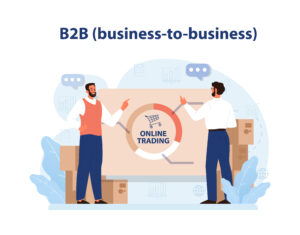The utility sector is rapidly recognizing the transformative power of B2B eCommerce solutions. In an industry traditionally bound by offline transactions and manual processes, the shift towards digital platforms is not just a trend but a strategic move to meet the evolving demands of the modern marketplace. B2B eCommerce solutions are emerging as vital tools for utility providers, offering the potential to significantly streamline operations, elevate customer service levels, and boost overall efficiency.
This digital transformation allows utility services to automate and optimize a variety of tasks, from billing and customer management to inventory control and service delivery. By adopting B2B eCommerce solutions, utility providers can not only enhance their operational workflows but also create more value for their customers through improved accessibility and convenience. The integration of eCommerce into utility operations is becoming indispensable for those looking to stay competitive and responsive in the digital age.
Understanding the Integration Process
For utility providers, integrating B2B eCommerce solutions with existing systems such as ERP and CRM translates into a unified operation where data and processes flow seamlessly. This integration is key to enhancing operational efficiency, ensuring data accuracy, and reducing manual workload through automation. It enables real-time updates on billing, service usage, and customer management, which in turn, improves customer satisfaction by offering accurate and timely information. Furthermore, this integrated approach allows for the provision of self-service portals, empowering customers to manage their accounts and services independently. Overall, the integration of B2B eCommerce platforms in utility operations not only streamlines backend processes but also enriches the customer experience, setting a new standard in service delivery within the utility sector.
Pre-Integration Considerations
Before embarking on the integration of a B2B eCommerce solution into utility operations, it’s essential to conduct a thorough assessment of current systems and define clear integration goals. This preparatory phase lays the groundwork for a successful implementation by ensuring the chosen solution aligns with your operational needs and objectives.
Assessing Current Systems
Begin by evaluating your existing infrastructure, including ERP, CRM, and any other operational systems. Understanding the capabilities and limitations of your current setup helps identify what you need from an eCommerce solution to enhance or complement these systems effectively.
Identifying Integration Goals
Define what you aim to achieve with this integration. Goals may include improving operational efficiency, enhancing customer service, automating billing processes, or gaining better insights into customer behavior. Clear objectives will guide the selection of an eCommerce platform that meets these specific needs.
Choosing the Right B2B eCommerce Solution
Selecting an eCommerce solution that fits seamlessly into your utility operations involves considering several factors:
- Compatibility: Ensure the platform can integrate smoothly with your existing systems.
- Scalability: Choose a solution that can grow with your business and handle increasing transaction volumes.
- Security: The platform must have robust security measures to protect sensitive customer and operational data.
- Functionality: Look for features that support your integration goals, such as advanced billing options, customer self-service portals, and comprehensive analytics.
Steps for Successful Integration
Integrating a B2B eCommerce solution into utility operations requires careful planning and execution. Here’s a roadmap for a successful integration:
Planning and Strategy Development:
- Set Clear Objectives: Begin by defining clear, measurable objectives for the integration. Are you looking to streamline billing processes, enhance the customer service experience, or perhaps improve inventory management? Identifying specific goals early on guides the direction of the integration, ensuring that every decision made contributes towards achieving these targets. Clear objectives also provide a benchmark for evaluating the success of the integration.
- Involve Stakeholders: Integration is not a task for IT alone; it impacts various facets of the utility operations. As such, involving key stakeholders from the outset is crucial. This includes representatives from customer service, finance, operations, and any other department that will interact with the B2B eCommerce platform. Engaging these stakeholders helps in gathering a broad range of insights and expectations, which are invaluable in crafting a comprehensive integration strategy that addresses the needs of the entire organization.
Choosing the Right Integration Platform:
- Criteria for Selection: The ideal platform should align perfectly with the needs of utility operations, offering specific features that cater to the industry’s unique requirements. Key functionalities to look for include real-time billing, which ensures accuracy and timeliness in customer invoicing, and a self-service portal that empowers customers to manage their accounts, place orders, and resolve issues independently, enhancing their overall experience.
- Scalability and Security: Select a platform that can adapt and grow alongside your business. Scalability is essential for accommodating an expanding customer base, increased transaction volumes, and the addition of new services without compromising performance. Equally important is the platform’s security infrastructure. Robust security measures, including data encryption and secure payment processing, are critical for protecting sensitive customer information and maintaining trust. Ensuring compliance with relevant data protection regulations, such as GDPR, is also a must for any platform under consideration.
Data Synchronization and System Compatibility:
- Compatibility Checks: To facilitate a smooth B2B eCommerce integration in utility operations, it’s crucial to perform thorough compatibility checks. This involves verifying that the eCommerce platform can integrate flawlessly with your current ERP and CRM systems, ensuring uninterrupted data flow and operational continuity.
- Effective Migration: Developing a robust strategy for data migration is essential in the B2B eCommerce integration process for utility operations. This strategy should prioritize maintaining data accuracy and minimizing downtime, which is critical for preserving service quality and customer trust during the transition.
Customization and User Experience Optimization:
- Tailor the Platform: Customizing the eCommerce platform to suit the specific demands of your utility services and operational workflows is essential. This customization ensures the platform aligns with the unique aspects of utility operations, from billing cycles to service delivery, thereby enhancing operational efficiency and effectiveness.
- Enhance User Interface: A key aspect of B2B eCommerce integration in utility operations involves optimizing the user interface (UI) for both customers and employees. An intuitive, easily navigable UI improves the overall user experience, facilitating smoother interactions with the platform. This not only boosts customer satisfaction but also empowers employees, enabling them to manage operations more efficiently.
Testing and Quality Assurance:
- Comprehensive Testing: The integrated system must undergo extensive testing to uncover and rectify any potential issues before the platform is officially launched. This thorough testing should cover all aspects of the B2B eCommerce integration, including data synchronization, user interface functionality, and the seamless operation of customized features. Identifying and addressing these issues early in the process helps avoid disruptions in utility services once the platform goes live.
- Feedback Loops: Incorporating feedback mechanisms is essential for fostering continuous improvement of the B2B eCommerce platform. These feedback loops can come from user experiences, system performance data, and stakeholder input. Actively seeking and implementing feedback ensures the platform not only meets current utility operations needs but also adapts to future demands and technological advancements.
Training and Support:
The final, yet equally crucial, step in B2B eCommerce integration for utility operations revolves around comprehensive staff training and robust technical support. Ensuring your team is well-equipped and support structures are in place is key to unlocking the full potential of the new system.
- Staff Training: It’s imperative to provide detailed training sessions for your team to familiarize them with the new B2B eCommerce platform. Effective training ensures that staff members can confidently navigate the system, manage tasks efficiently, and leverage the platform’s features to improve utility operations. This education should cover all aspects of the system, from basic navigation to advanced functionalities, tailored to the specific roles of different team members.
- Technical Support: Establishing a solid technical support framework is critical for addressing any issues that arise quickly. This support ensures the continuous, smooth operation of the eCommerce platform, minimizing downtime and maintaining service quality. A reliable support system can include access to a dedicated helpdesk, regular system updates to fix bugs and enhance security, and ongoing consultations to optimize platform use.
Maximizing Benefits of B2B eCommerce Integration for Utilities
Integrating B2B eCommerce platforms can significantly enhance utility operations and customer satisfaction. By ensuring systems work together seamlessly, utilities can automate processes, cut down on manual errors, and improve efficiency. This integration offers customers a smoother experience with self-service options, boosting their satisfaction.
Additionally, the data gathered from these integrated platforms is invaluable. Analytics can reveal customer trends, help in making informed decisions, and aid in strategic planning. This leads to better service alignment with customer needs and more effective resource use. In essence, leveraging integration and analytics allows utilities to streamline operations and better serve their customers, setting a foundation for ongoing growth and innovation.
Conclusion
In conclusion, integrating B2B eCommerce solutions into utility operations significantly boosts efficiency and customer satisfaction. At Total.one, we stand ready to guide utility providers on this transformative journey. Our solution is crafted for strategic integration and continuous improvement, ensuring long-term success. We invite utility providers to partner with us, leveraging our expertise and innovative platform to navigate the digital landscape confidently. Total.one is your ally in achieving operational excellence and future-proofing your services. Contact us today!



